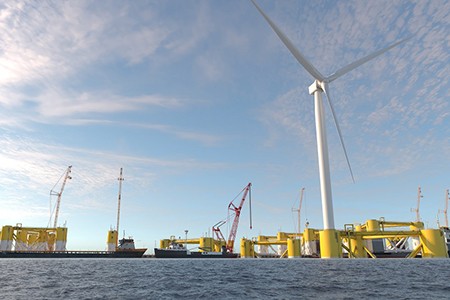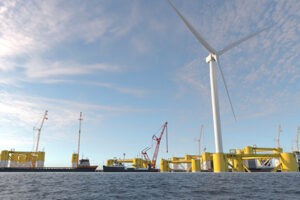Photo: Port of Long Beach
BY STAS MARGARONIS
On May 10th, the Pacific Offshore Wind Summit, hosted by Offshore Wind California, heard federal, state and industry leaders urge California to move with speed and scale to make offshore wind a reality. The steps include transmission, port upgrades, procuring at scale, expediting permits, establishing a supply chain, creating workforce training and providing suitable sea space to reach the state’s energy goals.
Conference organizers noted that in 2022 the California Energy Commission (CEC) adopted offshore wind planning goals, as directed by California Assembly Bill 525 aimed at generating up to 5 GW (gigawatts) by 2030 and 25 GW by 2045.
In December, the Bureau of Ocean Energy Management (BOEM) held its first-ever federal auction for California offshore wind, identifying five provisional leaseholders to deploy an initial 5-7 GW at Morro Bay and Humboldt off the state’s Central and North Coasts.
Proposed Port of Long Beach Wind Port
During the conference, the Port of Long Beach announced a plan to establish a 400-acre wind port called Pier Wind that could centralize the manufacture and staging of floating offshore wind turbines on the West Coast and provide a major infrastructural boost to California’s planned goal of building floating wind farms.
On May 9th the Port of Long Beach announced: “The Port of Long Beach (POLB) has the potential to play a critical role in supporting the offshore wind industry to help meet the state and federal offshore wind deployment goals.”
In addition, POLB “… is evaluating the opportunity to develop an approximately 400-acre terminal known as Pier Wind. This offshore wind terminal will be developed to have the flexibility to serve any of the offshore wind industry needs (i.e., staging and integration (S&I), foundation fabrication, component manufacturing, maintenance support, etc.). In addition, the terminal will meet the physical, regulatory, and environmental requirements to accommodate the largest floating offshore wind turbine generator (WTG) components and floating foundations being developed. This report documents the engineering decisions completed during the conceptual phase of the project.”
Meanwhile, back at the Pacific Offshore Wind Summit:
Tommy Beaudreau, Deputy Secretary, U.S. Department of Interior told attendees: “It’s amazing in less than 5 years how far offshore wind has advanced in the Pacific … We’re laser-focused on building our nation’s domestic offshore wind economy.”
Alice Reynolds, President, California Public Utilities Commission (CPUC) exclaimed: “Imagine large-scale floating offshore wind farms off the coast of California. This is an enormous opportunity, not only to take the lead building and implementing renewable resources but also spurring jobs,”
Christine Hironaka, Deputy Cabinet Secretary for California Governor Newsom told attendees: “Governor. Newsom is committed to a future of offshore wind in California, including his nation-leading goal of 25 GW by 2045 … We’re on a path to achieve our 100% clean energy future by 2045. … This is why I’m so excited about the innovative opportunity of offshore wind.”
Conference organizers also noted that The National Renewable Energy Laboratory (NREL) estimates California’s technical offshore wind potential at 200 GW, with more than 25 GW in BOEM’s two lease areas and two wind study areas. Deeper West Coast waters require floating technologies that are already being deployed in other world markets. Reports show that developing 25 GW of California offshore wind will support tens of thousands of jobs, supply up to 15-20 percent of the state’s planned new clean energy, save ratepayers billions of dollars and generate enough competitively priced electricity to power up to 25 million homes.
Permitting Challenges
On May 10th, the Biden Administration called on Congress to pass permitting legislation that would help speed up clean energy and fossil fuel projects as the bipartisan effort gets pulled into a standoff on the debt ceiling, according to a Reuters report.
Republicans have made permitting reform a priority and Biden, who last year supported a bill from Senator Joe Manchin, a fellow Democrat, indicated on Tuesday to House Speaker Kevin McCarthy that he was open to discussing the issue as part of the talks.
White House climate adviser John Podesta called for delinking issues like permitting reform from the debt ceiling fight.
The reform measures that apply to oil and gas projects are opposed by progressive Democrats and environmental groups who say they could green light dangerous projects.
“Right now, the permitting process for clean energy infrastructure, including transmission, is plagued by delays and bottlenecks,” Podesta said.
“These delays are pervasive at every level of government, federal, state and local. We got so good at stopping projects that we forgot how to build things in America.”
At the Pacific Offshore Wind Summit in 2022, Andrew Meredith, President, State Building Trades Council of California said he was concerned that California environmentalists’ opposition and the State’s lengthy permit approvals process will delay construction of floating offshore wind farms for years.
In 2022, Meredith told the American Journal of Transportation that he does not believe that commencing construction of proposed floating wind farms off the coasts of Humboldt Bay and Morro Bay can begin by developers’ projected goal of 2030.
He said California’s lengthy permit approval process will not allow it.
He also expressed the belief that some environmental organizations do not completely support deployment of offshore wind:
“We’ve heard a lot of optimism in the last three days about the potential for offshore wind in California and we hope that there are a lot of things we can accomplish by the State’s 2045 renewable energy goal. We also want to provide a reality about some of the hurdles that we have to overcome as a state to deploy offshore wind on a massive scale. Environmental organizations have not completely embraced the wind generation off the coast of California. We saw this at the State Lands Commission in 2021, when the first offshore wind demonstration projects were proposed off the coast of Vandenburg. We saw the state environmental organizations standing in opposition to offshore wind.”
Meredith said: “We can’t be a state that says no to any available technologies. We have to be a state that embraces that ‘can-do’ spirit again … If there is an opportunity to build offshore wind in state waters, we need to build it. The fact that blinking lights off the coast of California can impact the views of rich environmentalists shouldn’t be a barrier to the greater good.”
Meredith said that the California State Building Trades Council is working to streamline permit approvals in California to reduce delays of construction projects including renewable energy projects.
At the 2023 Pacific Offshore Wind Summit, Meredith said he was hopeful that a new project labor agreement to build two offshore wind turbines off the Vandenberg coast in Southern California would establish a model for future cooperation in California and energize a labor-management coalition to push for faster permit approvals.
State and Federal Officials Not Fast-Tracking Permit Approvals–Yet
That optimism was not immediately obvious at the 2023 conference.
State and federal officials speaking at conference panels indicated that they saw no urgency in fast tracking approvals for offshore wind farms. The message from these speakers appeared to be that established practice for environmental approvals going back 50 years were still relevant at a time of growing environmental crisis where the approval of renewable energy projects to replace fossil fuel generation contributes to preventing higher carbon emissions and a global climate crisis.
While panelists insisted on the need to thoroughly investigate any and all possible environmental aspects of offshore wind development at Humboldt and Morro Bay, there did not seem to be much recognition that offshore wind farms located 25 miles off the coast were different from wind farms located on and near land.
Several attendees at the conference expressed disappointment with the lack of a fresh perspective enunciated by State and Federal panelists.


